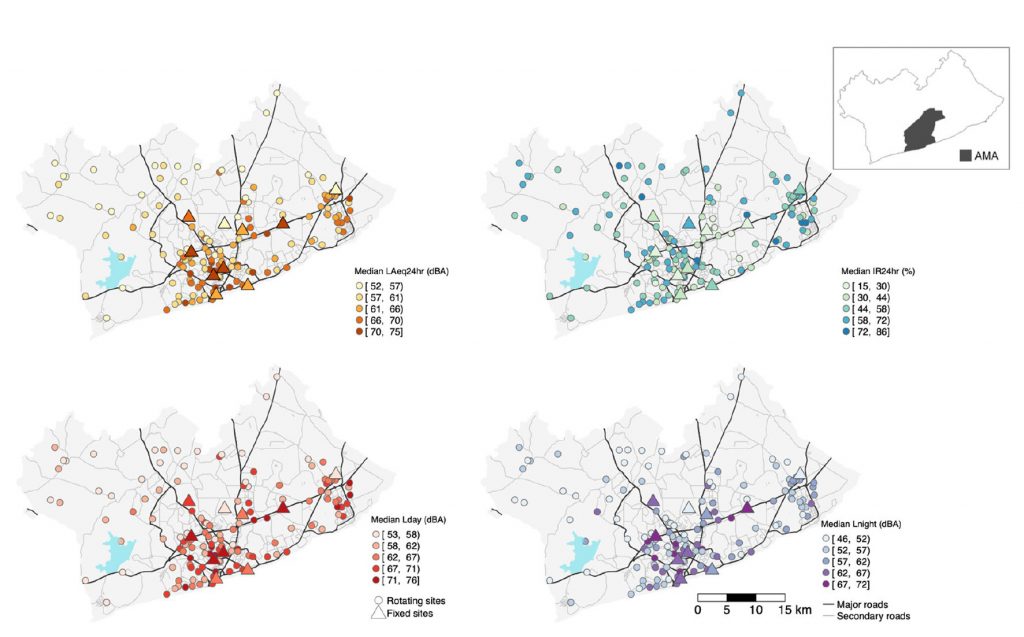
Sierra N. Clark, Abosede S. Alli, Ricky Nathvani, Allison Hughes, Majid Ezzati, Michael Brauer, Mireille B. Toledano, Jill Baumgartner, James E. Bennett, James Nimo, Josephine Bedford Moses, Solomon Baah, Samuel Agyei-Mensah, George Owusu, Briony Croft & Raphael E. Arku
Urban noise pollution is an emerging public health concern in growing cities in sub-Saharan
Africa (SSA), but the sound environment in SSA cities is understudied. We leveraged a large-scale
measurement campaign to characterize the spatial and temporal patterns of measured sound
levels and sound sources in Accra, Ghana. We measured sound levels and recorded audio clips at 146 representative locations, involving 7-days (136 locations) and 1-year measurements between 2019
and 2020. We calculated metrics of noise levels and intermittency and analyzed audio recordings
using a pre-trained neural network to identify sources. Commercial, business, and industrial areas and areas near major roads had the highest median daily sound levels (LAeq24hr: 69 dBA and 72 dBA) and the lowest percentage of intermittent sound; the vice-versa was found for peri urban areas. Road transport sounds dominated the overall sound environment but mixtures of other sound sources, including animals, human speech, and outdoor music, dominated in various locations and at different times. Environmental noise levels in Accra exceeded both international and national health-based guidelines. Detailed information on the acoustical environmental quality (including sound levels and types) in Accra may guide environmental policy formulation and evaluation to improve the health of urban residents.
[…]
Sound level measurement and audio. We used the Noise Sentry sound level meter datalogger (NSRT_mk3) from Convergence Instruments, Canada to measure A-weighted sound levels (decibels (dBA)) 76. The digital MEMS microphone reduces the cost of the sound level meter but complies with Type 1 precision standards 80. The sound level meters were programmed to continuously capture sound levels which were integrated and logged every minute. Prior to each monitoring session, the sound level meters (SLM) were calibrated with a CA114 sound calibrator at 94.0 dB 0.3 dB and 1000 Hz 0.5% (Convergence Instruments, Canada). The Noise Sentry’s do have a noise floor of 30 dBA, though this is not a limitation of our study, which aimed to characterize the average noise trends in Accra across a large-scale. As well, pilot measurements conducted at 9 diverse locations in the city showed that even the ‘quietest’ site did not have an LAeq1min value which went below 34 dBA. Our SLMs were also field validated in a separate aircraft noise study conducted in San Francisco against a sophisticated Type I instrument (DUO 01 dB) 81 and the agreement was high (mean and median second by second difference between the instruments was − 0.42 and − 0.38 dBA, respectively). In measurements conducted prior to our study, we also found good agreement between our SLMs and a Cirrus Optimus Red where the difference between monitoring period LAeq’s were less than 1 dBA. We also deployed low-cost audio recorders (AudioMoth, Open Acoustic Devices (Oxford, UK)) to record samples of the outdoor acoustical environment for analysis of sound sources. The audio recorders were co-located and recorded for 10 s every 10 min. We collected a temporally representative sample of the 10-s-long audio clips in order to represent the underlying distribution of sound source frequency over time. Specifically, we collected audio throughout the day (6 samples per hour, every hour) and across days (Monday–Sunday) at each measurement site in the city. For the fixed sites, we additionally have data spanning 12 months of the year. Collecting audio for 10-s snapshots also preserves individual privacy.
Read the complete scientific report from the nature.com website or download the PDF Article here.
Convergence Instruments 2020 © Tous droits réservés | Termes et conditions | Garantie Limitée